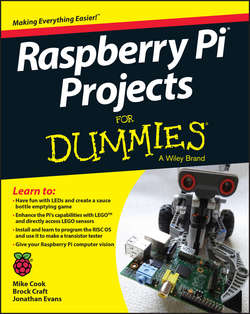Читать книгу Raspberry Pi Projects For Dummies - Evans Jonathan - Страница 17
На сайте Литреса книга снята с продажи.
Part I
Getting Started with Raspberry Pi Projects
Chapter 2
Setting Up Your Tools and Workbench
Getting Ready to Build Your Projects
ОглавлениеYou can start working on Raspberry Pi projects almost anywhere, but it’s best to have a dedicated spot in which to build them. Completing the projects will take some time, so you want to choose a place where you can work comfortably and see what you’re doing. Generally, setting up and taking down unfinished projects is a hassle – it takes more time and can introduce errors if your connections come loose. You can avoid this problem by setting aside a dedicated workspace.
Setting up your workspace
You need a dedicated area where you can build and test your projects – especially the advanced ones in this book, which can take a few hours or more. You have to connect all the components together, provide power, keep the cables and connection wires organized, and do some light fabrication. So, find a spot in your house, apartment, shed, garage, studio, or wherever, where you and your work will be undisturbed and where you can make a bit of a mess. The workspace in Figure 2-1 has all these things covered.
Figure 2-1: A good working environment and some basic tools.
You don’t want to get interrupted by distractions hunting for parts, or not having the right tools, so it’s important to get the work area ready. In our experience, a good Raspberry Pi workspace has the following:
✔ A solid workbench or desk
✔ A comfortable chair
✔ Dry air and good ventilation (especially for evacuating soldering fumes)
✔ Plenty of power outlets, ideally at desk height
✔ Enough room for the screen, keyboard, and mouse, and some extra workbench space for assembly and fabrication
✔ A nearby network connection or Wi-Fi router
✔ Shelving and storage for projects you’re working on
✔ Small boxes and drawers for organizing parts and tools
The environment needs to be comfortable to work in for a long stretch. If it’s too cold or too hot, too noisy, or filled with distractions, it’ll take you longer to complete the work. Make yourself a sort of hideaway where you can stay focused.
Your Raspberry Pi is a fine computer in its own right, but an extra computer is sometimes useful during the project-building process, so it’s good to have room for a desktop or laptop computer on the workbench. Plus, you’ll want to be able to hunt for references online, look up datasheets, and post questions to forums, so a reliable Internet connection is vital.
Keeping an eye on safety
A few of the projects in this book deal with low-voltage electronics. Safety is always a factor when working with electrical circuits. None of these projects works with wall power, but you should always treat electronic projects as if they could have potentially dangerous voltages. If children may roam around your work area, take special precautions to keep them away. Little kids love pulling on cords and cables and could easily drag everything off your desk with one quick tug. A hot soldering iron left unattended could cause severe burns, besides being a fire hazard.
It’s probably best to keep food and drink separate from your workbench. Empty pizza boxes or soda cans may hide critical parts, and you can waste time hunting for things. Accidentally spilled drinks don’t do good things for live circuits.
